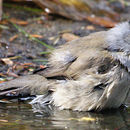en
names in breadcrumbs


Ortega-Olivencia et al. (2005) identified the first known example of a native European plant that is pollinated primarily by birds. They found that the legume Anagyris foetida, a rare shrubby component of the Mediterranean scrub of the eastern and southern Iberian Peninsula, is pollinated mainly by three sylviid warblers: Blackcap (Sylvia atricapilla), Sardinian Warbler (Sylvia melanocephala), and Chiffchaff (Phylloscopus collybita). These birds visit the flowers seeking nectar. Although their usual diet at other times of the year consists mainly of insects and spiders, fruit is often an important part of the Blackcap's diet in fall and winter (Ehrlich et al. 1994), and nectar can be important as well. The authors note that Anagyris foetida flowers during the autumn and winter, a period characterized by cold, high winds, almost daily mists that persist until nightfall, and abundant rainfall. These conditions are unfavorable to most insects that could serve as pollinators for Anagyris or as food for Blackcaps, a situation predisposing these two species to evolve a mutually beneficial relationship.
The male (and sometimes female) Blackcap sings from cover below the canopy (Ehrlich et al. 1994).
Bearhop et al. (2005) reported that birds from recently evolved allopatric (i.e., geographically non-overlapping) wintering populations of Blackcaps tend to mate assortatively on their shared breeding grounds (i.e., birds from one wintering area are more likely to mate with birds from the same wintering area).
The Blackcap is common to very common over most of its range. In Europe (which accounts for ~75% of its breeding range) it is one of the most abundant birds. The total world population is probably close to 70 million pairs (Aymi and Gargallo 2006).
The Blackcap is a common and familiar bird over large parts of central and southern Europe. It is mainly migratory in the northern and eastern part of its breeding range. Increasingly in recent decades, however, it may be a short-distance migrant or resident in the west and south (Mullarney et al. 2000; Ehrlich et al. 2000).
Some Blackcaps now overwinter even in central and northern Europe, especially in urban and suburban areas (Aymi and Gargallo 2006). Fifty years ago, the Blackcap was considered a summer visitor to northern Europe and the British Isles. However, an increasing number of birds began overwintering in Britain and Ireland, in numbers growing from a few individuals in the early 1960s to the point where a recent survey of birdwatchers found that 31% of their gardens had Blackcaps visiting bird tables from October 2003 to March 2004. Work in the early 1990s showed that the birds overwintering in Britain and Ireland actually bred in south central Europe and that this newly evolved migratory behavior was associated with genetic differences. The main wintering areas associated with Blackcaps breeding in south central Europe (and therefore the ancestral wintering areas for the British and Irish birds) are southern Iberia and North Africa. The new wintering area is disjunct from the original, and birds wintering in Britain and Ireland display a completely different migratory orientation (Bearhop et al. 2005 and references therein). It has been suggested that the rapid evolution of distinct migratory pathways and wintering habits has been made possible by allochronic (i.e., differently timed) spring arrival of migrants from their respective wintering quarters resulting in assortative mating. In this scenario, individuals tend to mate with other individuals from the same wintering areas, which would facilitate independent evolutionary trajectories. Although differently timed spring arrival and the resulting non-random mating are likely important factors in the evolution of the new migration pattern, Rolshausen et al. (2010) concluded that differences in spring arrival dates are not sufficient to explain the observed degree of assortative mating.
Many Blackcaps from the eastern portion of their breeding range winter in sub-Saharan East Africa (Aymi and Gargallo 2006).
Breeds in shady woodlands with dense understory and in parks and gardens with significant undergrowth. Nests low in bushes (Mullarney et al. 2000). In winter, tends to occur more in bushy areas rich in berries and other fruits. Found from sea level to treeline (Aymi and Gargallo 2006).
Mullarney et al. 2000: Small sylviid warbler (length 13.5-15 cm), stocky build, dirty gray above and light olive gray below. Male with small black cap (reaching only to upper part of eye; female and juvenile have red-brown cap). Bill and legs gray.
A partially melanistic morph (i.e., a form with increased dark pigmentation) occurs on Atlantic islands and rarely in continental Europe (Aymi and Gargallo 2006).
The Garden Warbler (Sylvia borin) is the Blackcap's closest extant relative (Aymi and Gargallo 2006).